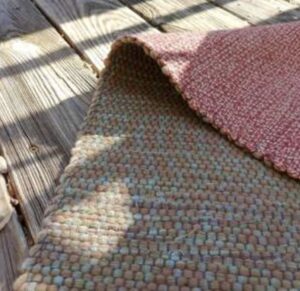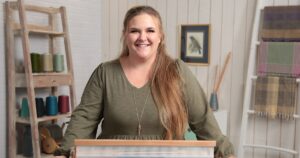Reversible Rag Rugs
Sara Bixler
 Can you imagine weaving a Rag Rug that has two totally different sides?!! Picture a bright floral print for summer, and warm autumn colors contrasting on the other side, for the most versatile rug in your home as the seasons change. And just think of all the fun you’ll have showing off your two-faced rug to other weaver friends and your guests!
Can you imagine weaving a Rag Rug that has two totally different sides?!! Picture a bright floral print for summer, and warm autumn colors contrasting on the other side, for the most versatile rug in your home as the seasons change. And just think of all the fun you’ll have showing off your two-faced rug to other weaver friends and your guests!
During your time with Sara you’ll discuss how the magic happens, as a result of a unique tie-up and treadling order which allows the warp to stitch the different wefts to the top and bottom layers, creating the reversible design.
You’ll also examine how this technique can be applied to other two-faced fabrics such as placemats, upholstery fabric and fashion fabrics that have a woven lining. And all under the guiding hand of a well-known weaving school teacher!
SKILL LEVEL: Students must have an intermediate level of experience, a strong comprehension of drafting notations for multi-harness looms, and some rug weaving experience, as we will be building upon previous knowledge.
EQUIPMENT: Looms will need to be dressed in advance per instructor’s warping instructions on a good-working 4-shaft loom which they are familiar with. Two ski or rug shuttles. Metal temple (optional).
PRE-WORKSHOP PREP: Warp loom per instructions. Students will be asked to bring six yards of fabric for each side, totaling 12 yards of 45″ wide fabric. Sara personally loves batiks and true woven plaids, but any cotton fabric with good color definition on both sides will work wonderfully. Pre-wash and dry your fabric prior to class but DO NOT cut your fabric.
MATERIALS FEE: $10
 Sara is the owner and resident instructor of Red Stone Glen Fiber Arts Center. Many of Sara’s students praise her ability to guide students through the challenging world of color theory, specifically relating to weaving. Sara has spent many years experimenting with color in weaving, focusing her studies on how color relationships are affected by yarn size, luster, sett and weave structure. She loves giving students core principals to follow so they become more confident in their color decisions when designing new pieces.
Sara is the owner and resident instructor of Red Stone Glen Fiber Arts Center. Many of Sara’s students praise her ability to guide students through the challenging world of color theory, specifically relating to weaving. Sara has spent many years experimenting with color in weaving, focusing her studies on how color relationships are affected by yarn size, luster, sett and weave structure. She loves giving students core principals to follow so they become more confident in their color decisions when designing new pieces.
